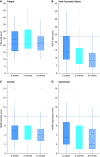Persistent Health Problems beyond Pulmonary Recovery up to 6 Months after Hospitalization for COVID-19: A Longitudinal Study of Respiratory, Physical, and Psychological Outcomes
- PMID: 34582728
- PMCID: PMC8996273
- DOI: 10.1513/AnnalsATS.202103-340OC
Persistent Health Problems beyond Pulmonary Recovery up to 6 Months after Hospitalization for COVID-19: A Longitudinal Study of Respiratory, Physical, and Psychological Outcomes
Abstract
Rationale: Data on longitudinal recovery after hospitalization for coronavirus disease (COVID-19) currently remain scarce, just as outcomes beyond 3 months of follow-up do. Objectives: To evaluate the sequelae up to 6 months after hospitalization for COVID-19 by considering 1) recovery as it relates to pulmonary function, radiological abnormalities, physical and mental health status, and health-related quality of life (HR-QoL) and 2) the predictors of the most clinically relevant sequelae. Methods: Patients were evaluated at 6 weeks, 3 months, and 6 months after hospitalization by using pulmonary function testing, radiological evaluation, and online questionnaires on the physical and mental health status and HR-QoL. Outcomes were analyzed using repeated-measurement analyses. Results: Ninety-two patients were included (mean age, 58.2 ± 12.3 yr; 58 [63.0%] men). The estimated percentage of patients with impaired forced vital capacity improved from 25% at 6 weeks to 11% at 6 months; for impaired diffusion capacity, this percentage improved from 63% to 46%. Radiologically, ground-glass opacity decreased but fibrosis persisted. The majority of patients (89.1%) still reported one or more symptoms 6 months after discharge. Fatigue decreased significantly over time (P = 0.006). Nonetheless, fatigue remained in 51% of the patients at 6 months. HR-QoL (nearly) normalized in most domains at 6 months, except for physical role functioning, with persistent fatigue and the length of hospitalization being the most important predictors. Conclusions: During the first 6 months after hospitalization for COVID-19, most patients demonstrated continuing recovery across all health domains, but persistent sequelae were frequent. Fatigue was the most frequent residual and persistent symptom up to 6 months after hospitalization, importantly impacting HR-QoL.
Keywords: coronavirus disease; fatigue; patient-reported outcomes; pulmonary function; trajectories of recovery.
Figures



References
-
- Wiersinga WJ, Rhodes A, Cheng AC, Peacock SJ, Prescott HC. Pathophysiology, transmission, diagnosis, and treatment of coronavirus disease 2019 (COVID-19): a review. JAMA . 2020;324:782–793. - PubMed
Publication types
MeSH terms
LinkOut - more resources
Full Text Sources
Medical

